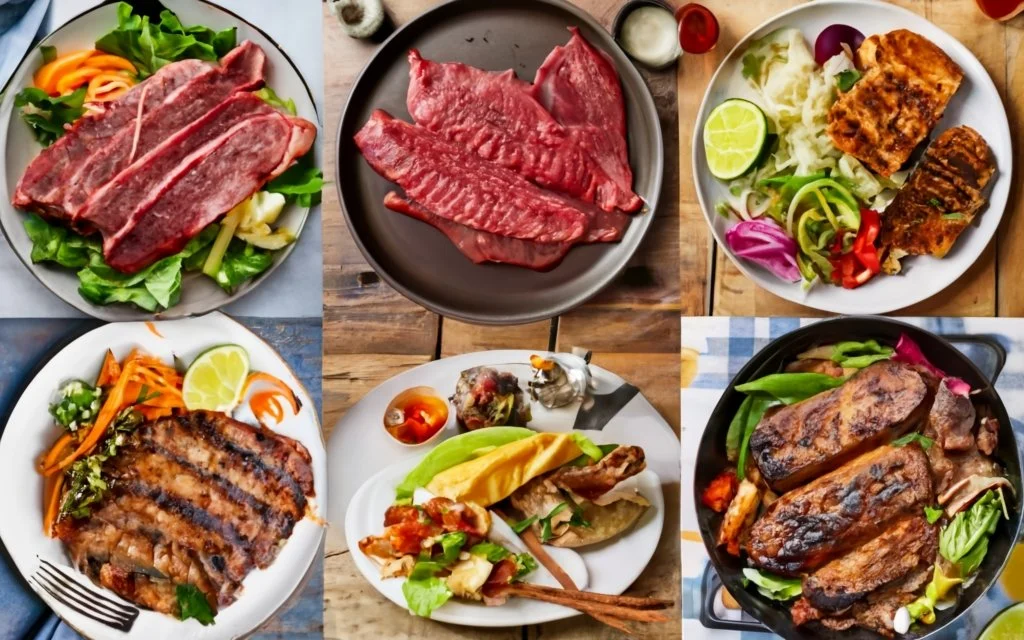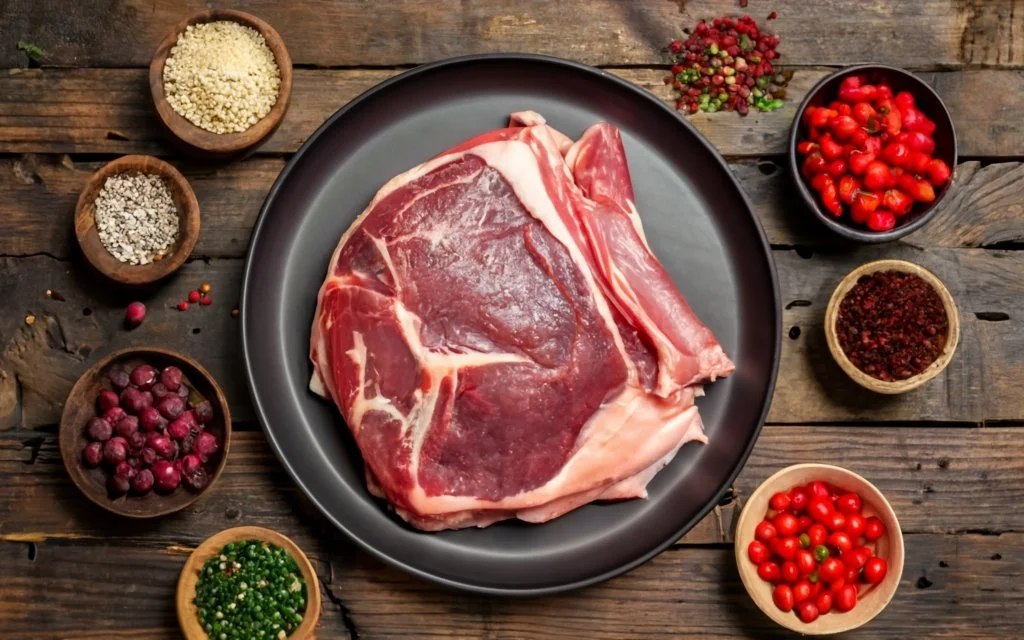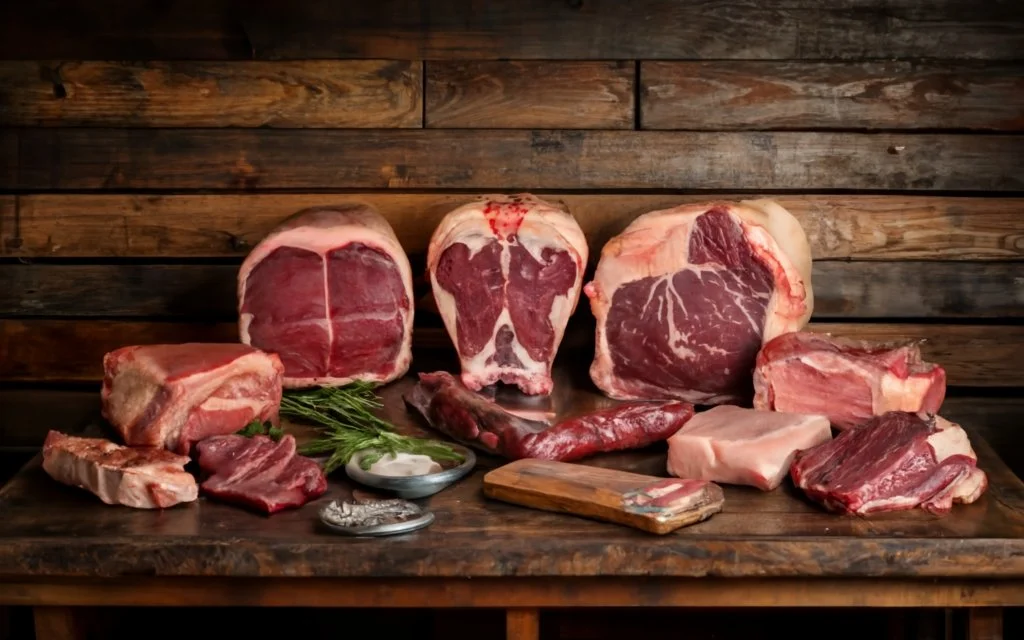What is Flap Meat?
Origins and Popularity
meat, also known as bottom sirloin butt, is a cut of steak that’s been hiding in plain sight, savored by butchers and chefs in the know. Originating from the lower belly of the cow, this cut is nestled near the flank and round, making it a close cousin to more well-known cuts like flank steak. Its rise to fame has been a quiet one, but as savvy consumers seek out delicious and cost-effective alternatives to pricier cuts, flap meat’s popularity has soared.

Flap Meat vs. Other Cuts
At first glance, meat might just seem like another beef cut, but oh, it’s so much more! Its texture and grain are akin to that of flank, hanger, and skirt steaks, making it a versatile player in the kitchen. Typically weighing in at 3 to 4 pounds, it’s a hearty option that doesn’t skimp on flavor or size. Price-wise, it’s a savvy choice, often coming in at a similar cost to flank steaks, but with a taste and tenderness that can rival the more expensive skirt steaks.
Now, let’s talk cooking! Flap meat is like a sponge for flavors, making it a perfect candidate for your favorite marinades. But remember, this isn’t a cut you rush. It deserves your time and attention, from a loving marinade to a rest after cooking to ensure every bite is as juicy and flavorful as possible. And when it’s time to serve, slicing against the grain is the secret to tender, melt-in-your-mouth slices.
So, why not give flap meat a try? It’s a cut that offers the perfect balance of flavor, versatility, and value, ready to take your culinary creations to the next level!
In the next section, we’ll dive into the art of marinating and cooking flap meat to perfection, so stay tuned for some sizzling tips and tricks!
Comprehensive Guide on Flap Meat – For more detailed insights and cooking inspirations, check out the Food Network’s extensive guide on flap meat.
How to Cook Flap Meat
Cooking flap meat is an adventure in flavors and textures, and with the right techniques, you can transform this humble cut into a culinary masterpiece. Let’s break down the steps to ensure your flap meat is cooked to perfection every time.
Marinating Techniques
Before you even think about cooking, let’s marinate! Flap meat is like a flavor sponge, eagerly soaking up whatever delicious concoctions you can dream up. To start, consider a marinade that balances acidity, sweetness, and savory elements. Citrus juices, vinegars, or even a splash of wine can tenderize the meat, while herbs and spices infuse it with depth and complexity. Remember, patience is key! Allow your meat to marinate for several hours, or even overnight, to ensure every fiber is bursting with flavor.
Cooking Methods
Once your meat is marinated and ready, it’s time to cook! beef flap is best cooked quickly over high heat. Whether you’re grilling outdoors or searing in a hot skillet, aim for a cooking time that leaves the meat charred on the outside but still tender and juicy inside. This usually means just a few minutes per side. Keep an eye on the heat and don’t be afraid to let it develop a nice, caramelized crust – that’s where a lot of the flavors lie!
Tips for Perfect Flap Meat

Here are some insider tips to elevate your flap meat game:
- Keep it Whole: Resist the urge to cut the meat into smaller pieces before cooking. Keeping it whole ensures even cooking and makes it easier to manage on the grill or pan.
- Don’t Overcook: Flap meat is best enjoyed medium-rare to medium. Overcooking can lead to a tougher texture, so watch your timing closely.
- Rest and Slice: After cooking, let your meat rest covered in foil for about 5 minutes. This allows the juices to redistribute, ensuring a moist and tender bite. When slicing, always go against the grain for the tenderest results.
Cooking flap meat is a journey of discovery, with each step offering the opportunity to infuse more flavor and tenderness into the meat. Experiment with different marinades and cooking techniques to find your perfect flap meat preparation. And remember, whether you’re a seasoned grill master or a kitchen novice, the key to perfect flap meat is a dash of patience and a sprinkle of love!
Stay tuned for the next section, where we’ll explore some mouth-watering recipes to make the most of your perfectly cooked beef flap!
In-depth Flap Meat Cooking Techniques – Dive deeper into the world of flap meat with Serious Eats’ comprehensive cooking guide.
Flap Meat Recipes
Now that you’re familiar with the basics of preparing and cooking flap meat, let’s explore some delicious recipes that showcase its versatility and rich flavor. Whether you’re in the mood for something traditional or looking to experiment with global cuisines, flap meat is the perfect canvas for your culinary creations.
Traditional Recipes
Flap meat’s robust flavor and tender texture make it ideal for classic dishes. Here are a couple of traditional recipes to get you started:
- Grilled Flap Steak: Marinate your flap meat in a mixture of olive oil, garlic, and your favorite herbs. Grill over high heat for a few minutes on each side, then let it rest. Slice against the grain and serve with a side of grilled vegetables for a classic, hearty meal.
- Flap Meat Tacos: Infuse your flap meat with a blend of cumin, chili powder, and lime juice. Grill or pan-sear until it’s charred and juicy. Slice it up and serve in warm tortillas with fresh salsa, cilantro, and a squeeze of lime for a taco night that’s sure to impress.
Innovative Dishes
If you’re looking to get creative, flap meat’s versatility makes it an excellent choice for dishes from all corners of the globe. Here are some ideas to inspire your next meal:
- Asian-Style Stir Fry: Thinly slice your flap meat and marinate it in soy sauce, ginger, and sesame oil. Stir-fry with a medley of vegetables and serve over steamed rice for a quick and flavorful weeknight dinner.
- Mediterranean Flap Meat Skewers: Cube your flap meat and marinate it in a mixture of yogurt, lemon juice, and Mediterranean spices. Thread the meat onto skewers and grill until charred and tender. Serve with a side of tzatziki and warm pita bread for a feast of flavors.
beef flap is a chameleon in the kitchen, able to take on a wide array of flavors and cooking styles. These recipes are just the beginning of what you can achieve with this versatile cut. So, don’t be afraid to experiment and let your culinary imagination run wild!
In the next section, we’ll delve into the nutritional profile of flap meat and how it can fit into a healthy and balanced diet. Stay tuned for more insights and tips!
Grilled Sirloin Flap Steak Recipe – For a detailed recipe and more ideas on how to grill your flap meat to perfection, check out this resource.
Health Benefits
meat is not only delicious but also packs a punch in terms of nutrition. Here are some of the key benefits:
- Protein-Packed: Like most cuts of beef, flap meat is an excellent source of high-quality protein, essential for muscle building and repair, as well as overall body function.
- Rich in Vitamins and Minerals: meat contains vital nutrients, including B vitamins (especially B12), zinc, selenium, and iron, which are crucial for energy production, immune function, and more.
- Lower in Fat: Compared to some other cuts, meat can be relatively lean, especially if you trim away excess fat. This makes it a suitable option for those looking to enjoy beef without overloading on saturated fats.
Considerations

While flap meat offers various health benefits, there are a few considerations to keep in mind:
- Moderation is Key: As with all red meats, it’s important to consume flap meat in moderation as part of a balanced diet. Overconsumption of red meat has been linked to certain health issues, so enjoy it alongside a variety of other protein sources.
- Cooking Methods Matter: The way you prepare flap meat can impact its healthfulness. Grilling or broiling can be healthier options compared to frying, and be mindful of the marinades and seasonings you use to keep sodium and sugar in check.
- Source Matters: Whenever possible, opt for grass-fed and organic beef flap, as it can have a better nutritional profile, including higher levels of omega-3 fatty acids and antioxidants.
Incorporating flap meat into your diet can be a delicious way to enjoy beef’s rich flavors while reaping its nutritional benefits. By understanding its nutritional content and making mindful choices about preparation and consumption, you can enjoy beef flap as a healthy part of your culinary repertoire.
Purchasing and Storage
To enjoy the best of what flap meat has to offer, it’s crucial to know how to select the freshest cut and store it properly. This section will guide you through the process of purchasing and storing meat, ensuring that every bite is as delicious as it should be.
Where to Buy
Flap meat is becoming increasingly popular, but it’s still not as commonly found as other cuts. Here’s how to ensure you get the best quality:
- Butcher Shops: Your local butcher is often the best source for fresh, high-quality flap meat. They can provide you with information about the meat’s origin and even give you tips on how to cook it.
- Specialty Stores: Look for beef flap at stores that specialize in high-quality meats or international foods. They often source unique cuts and can be a great place to find flap meat.
- Online Retailers: Many online stores now offer a wide variety of meat cuts, including flap meat, delivered right to your door. Ensure the retailer is reputable and known for quality.
Storage Tips
Proper storage is key to maintaining the quality and safety of flap meat. Here are some tips to keep in mind:
- Refrigeration: If you plan to cook the beef flap within a couple of days, store it in the coldest part of your refrigerator, usually at the bottom. Keep it in its original packaging or wrap it tightly in plastic wrap or aluminum foil.
- Freezing: For longer storage, flap meat can be frozen for several months. Wrap it tightly in freezer-safe wrap or bags, removing as much air as possible to prevent freezer burn. Label it with the date, so you know when it was frozen.
- Thawing: When you’re ready to cook, the best way to thaw beef flap is in the refrigerator, allowing it to defrost slowly and evenly. Avoid thawing at room temperature, as it can lead to bacterial growth.
- Handling: Always wash your hands, utensils, and surfaces before and after handling raw beef flap to prevent cross-contamination.
Frequently Asked Questions
In this section, we’ll address some of the most common inquiries about sirloin tip, providing you with a comprehensive understanding of this versatile cut. Here are some FAQs that might help clear up any confusion and enhance your cooking experience.
What is the best way to cook flap meat?
The best way to cook beef flap is quickly over high heat, such as grilling or broiling. Because of its texture, it’s also fantastic when marinated. Always slice against the grain to ensure tenderness.
Can flap meat be substituted for other cuts in recipes?
Absolutely! beef flap is a great substitute for other similar cuts like skirt steak, flank steak, or hanger steak. Its texture and flavor profile make it versatile for a variety of dishes.
Is flap meat tough or tender?
sirloin tip can be incredibly tender if cooked properly. It’s important not to overcook it and to slice it against the grain. Marinating the meat can also help break down fibers and add tenderness.
How long should I marinate flap ?
For the best results, marinate flap for at least 1 hour, but ideally for several hours or even overnight. This allows the flavors to penetrate and tenderize the meat.
What are some common dishes using flap meat?
meat is commonly used in dishes like stir-fries, tacos, fajitas, and sandwiches. Its robust flavor and tender texture make it suitable for a wide range of recipes.
How do I know when meat is done cooking?
Flap is best enjoyed when cooked to medium-rare or medium. Use a meat thermometer to check for doneness; it should read 130°F for medium-rare and 135°F for medium.
Can flap be cooked from frozen?
While it’s possible to cook flap from frozen, it’s not recommended. Thawing the meat in the refrigerator before cooking will result in a more even and tender cook.

